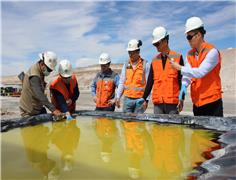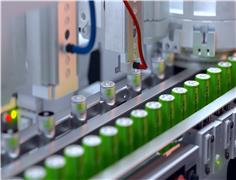- Write by:
-
Sunday, July 2, 2023 - 23:47:48
-
130 Visit
-
Print

Mining News Pro - Scientists at the US Department of Energy’s Argonne National Laboratory have discovered a fluorine electrolyte that could protect the next generation of lithium metal batteries against performance decline.
Fluorine, particularly in the form of sodium fluoride, is incorporated in many toothpastes to protect teeth against decay. The compound may also be the key to pushing non-lithium-ion batteries.
Sign Up for the Battery Metals Digest
According to the Argonne researchers, the chemistries of such devices offer twice or more energy stored in a given volume or weight compared to lithium-ion. They could power cars for much longer distances and could even power long-haul trucks and aircraft one day. The expectation is that the widespread use of such batteries will help address climate change. The main problem is that their high energy density declines rapidly with repeated charge and discharge.
“Lithium metal batteries with our fluorinated cation electrolyte could considerably boost the electric vehicle industry, and the usefulness of this electrolyte undoubtedly extends to other types of advanced battery systems beyond lithium-ion,” lead researcher John Zhang said in a media statement.
Zhang pointed out that one of the main contender has an anode made of lithium metal in place of the graphite normally used in lithium-ion batteries. It is thus called a “lithium metal” battery. The cathode is a metal oxide that contains nickel, manganese and cobalt (NMC). While it can deliver more than double the energy density possible with a lithium-ion battery, that outstanding performance rapidly vanishes within less than a hundred charge-discharge cycles.
Changing the electrolyte
The team’s solution involved changing the electrolyte, a liquid through which lithium ions move between cathode and anode to implement charge and discharge. In lithium metal batteries, the electrolyte is a liquid consisting of a lithium-containing salt dissolved in a solvent.
The source of the short cycle-life problem is that the electrolyte does not form an adequate protective layer on the anode surface during the first few cycles. This layer, also called solid-electrolyte-interphase (SEI), acts like a guardian, allowing lithium ions to freely pass in and out of the anode to charge and discharge the battery, respectively.
To address the issue, the Argonne scientists discovered a new fluoride solvent that maintains a robust protective layer for hundreds of cycles. It couples a fluorinated component that is positively charged (cation) with a different fluorinated component that is negatively charged (anion). This combination is called an ionic liquid.
“The key difference in our new electrolyte is the substitution of fluorine for hydrogen atoms in the ring-like structure of the cation part of the ionic liquid,” Zhang said. “This made all the difference in maintaining high performance for hundreds of cycles in a test lithium metal cell.”
Protective layer
Simulations at the Argonne Leadership Computing Facility’s Theta supercomputer revealed that the fluorine cations stick to and accumulate on the anode and cathode surfaces before any charge-discharge cycling. Then, during the early stages of cycling, a resilient SEI layer forms that is superior to what is possible with previous electrolytes.
High-resolution electron microscopy revealed that the highly protective SEI layer on the anode and cathode led to stable cycling.
The team, thus, was able to tune the proportion of fluoride solvent to lithium salt to create a layer with optimal properties, including an SEI thickness that is not too thick or thin. Because of this layer, lithium ions could efficiently flow in and out of the electrodes during charge and discharge for hundreds of cycles.
The group noted that the new electrolyte offers many other advantages as well. It is low cost because it can be made with extremely high purity and in one simple step rather than multiple steps. It is environmentally friendly because it uses much less solvent, which is volatile and can release contaminants into the environment. And it is safer because it is not flammable.
“Lithium metal batteries with our fluorinated cation electrolyte could considerably boost the electric vehicle industry,” Zhang said. “And the usefulness of this electrolyte undoubtedly extends to other types of advanced battery systems beyond lithium-ion.”
Short Link:
https://www.miningnews.ir/En/News/623088

Jiang Weiping, the founder of major Chinese lithium producer Tianqi Lithium Corp., resigned as chairman after the ...

BHP Group can’t cherry pick Anglo American assets without paying a hefty premium, Anglo investors told Reuters, ...

Marex Group Plc and a group of the London-based firm’s shareholders raised about $292 million in a US initial public ...

China’s Tianqi Lithium said on Thursday it has formally requested that a proposed joint venture between lithium company ...

India is in talks with several countries seeking partnerships for technical help on lithium processing, said four ...

Chile’s state copper company Codelco defended its proposed lithium production tie-up with SQM in response to criticism ...

Nigeria has revoked 924 dormant mining titles immediately and invites investors to freely apply for the affected ...

Chile’s state-run miner Codelco plans to select a partner for a future lithium project in one of the country’s top salt ...

A Native American group has asked all members of a US appeals court on Monday to overturn an earlier ruling that granted ...
No comments have been posted yet ...